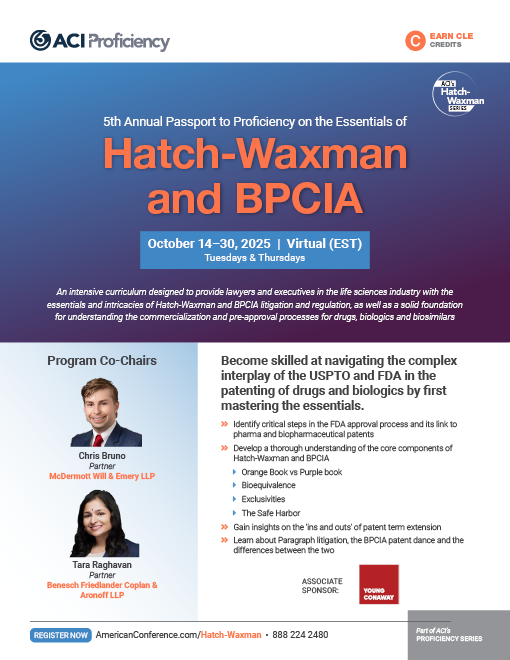Course Calendar (Eastern Standard Time)

Flip through our conference brochure and discover what’s new this year.
Download Brochure
Week 1 – Day 1
October 14, 2025
Key Agencies Overview
Understanding the Jurisdiction and Interplay of the FDA and PTO in the Patenting of Drugs and Biologics

Elizabeth CromptonCounselParker Poe

Kristi SawertPrincipal Fish & Richardson P.C.
Understanding the respective roles and interplay of the FDA and PTO in the patenting and approval of drugs and biological products
FDA
- FDA overview and organization
- Department of Health and Human Services and the Commissioner
- The 5 FDA Centers and the Office of Regulatory Affairs and their functions
- CDER (Drug) and CBER (Biologic) overview
- Defining the scope of the FDA’s jurisdiction with respect to drugs and biologics
- Examining how the FDA exercises its jurisdiction:
- Rule making
- Product decisions
- Enforcement
- Informal mechanisms
- Reviewing the laws that the FDA enforces relative to the patenting of drug and biological products
- Food Drug & Cosmetic Act
- Prescription Drug Marketing Act
- Public Health Services Act
- Hatch-Waxman Act
- Other applicable laws
- Defining drugs and biologics
- Labeling: when is a drug a drug and not a biologic
- Working with the FDA
- Administrative Procedures Act
- Formal and informal dispute resolution mechanisms
The PTO
- Review of the organizational structure of the PTO
- Patents: overview of drug and biological products that may be patented
- Who may apply for a patent? What are the requirements for patentability?
- Agency and inventorship
- What is the PTO’s jurisdiction in the patenting of drugs and biologics?
- What laws and regulations do the PTO enforce relative to the patenting of drugs and biologics?
- Overview of the Patent Trial and Appeals Court (PTAB) and its authority
- Trademarks and tradenames vis-à-vis drugs and biologics
Coffee Break
Identifying and Comprehending Pre-Commercialization Concerns Relative to Small Molecules and Biologics
- Reviewing the types of products that pharmaceutical, biotechnology and biopharmaceutical companies seeking to develop now
- Identifying impediments – through patent or regulatory restraint – which prevent these companies from pursuing the development of the desired product
- FDA hurdles that may not clear even if all patent and other IP hurdles are met
- Techniques for analyzing the value the product adds to the company’s portfolio, and methods for proving value
- Assessing the competition and analyzing potential therapeutic interchange considerations
- Understanding how the introduction of biosimilars has changed the commercial landscape
- Examining the role of the Center for Medicare and Medicaid Services (CMS) in the approval process and its impact on R&D
- The connection between CMS approval and commercial viability via government payor systems and rebates comparative effectiveness
Q&A Period
Ask the Faculty
Day One Adjourns
Week 1 – Day 2
October 16, 2025

Seth MailhotPartnerHusch Blackwell
Rx Drugs (new drugs)
- Identifying the application process for the approval of a new drug, i.e., small molecule, new chemical entities, etc.
- NDA (New Drug Application): definition, contents and regulatory overview
- INDA (Investigational New Drug Application) aka “IND”
- How does it differ from an NDA?
- Accelerated approvals
- Defining eligibility criteria for accelerated approval and priority reviews
- What portions of approval submissions might FDA release and when?
- Using advisory committees in the approval process
Biologics
- How does the approval process for a biologic differ from that of a drug?
- BLA (Biological Licensing Application): application and filing
- How does a biologic differ from a drug?
- Which products require BLAs instead of NDAs?
- Why is it a “license,” rather than an “approved application”?
Coffee Break

Jeanna WackerPartnerKirkland & Ellis LLP
Patent Protections for Drug and Biologics
- Summarizing the patenting process for drugs and biologics
- Strategies for building patent protection for drugs and biologics
- Applying for and achieving extension of patent term for time spent in the drug approval process
- Patent Term Extension (“PTE”) / Patent Term Adjustment (“PTA”) synopsis
- Reviewing the 271(e)(1) “safe harbor” provision
- Distinguishing the patenting process for drugs from that of biologics
Trademark, Trade Name, and Trade Dress Protections
- Overview of selecting a brand name for a proposed drug product
- Roles of the USPTO and FDA in the drug naming process
- Identifying the PTO and FDA clearances necessary for trade name/trademark approval on your product
- Understanding the importance of trade dress
- How does the branding process work for your product

Andrew WassonPartnerHaug Partners

Sara KoblitzDirectorHyman, Phelps & McNamara PC
- What is the Orange Book, what does it contain, and why is it orange?
- FDA’s publication on Approved Drug Products with Therapeutic Equivalence Evaluations
- Understanding the role of Orange Book listings in patent life cycle management and patent portfolio management
- Exploring the continuing dilemma of which patents should be listed, delisted, and held in reserve
- Examining the FDA’s position on not listing a patent
- Understanding the FTC’s new de-listing authority
- Overcoming challenges associated with listing patented information in the product label and indications discovered in clinical testing
- Incorporating long term patent listing strategies into label negotiations with FDA
- Examining the skinny labeling and carve–out conundrum
- Assessing the scope of potential Orange Book listing controversies relative to:
- Device patents
- Product-by-process claims
- Metabolites; polymorphs; intermediates
- Patents on unapproved uses
Q&A Period
Ask the Faculty
Co-Chair Closing Remarks and Week One Adjourns
Week 2 – Day 1
October 21, 2025

Gary VeronPartnerHogan Lovells LLP

Daniel OrrSenior Counsel Wilson Sonsini Goodrich & Rosati
- Overview of Hatch-Waxman and reforms
- Comparing the NDA, 505(b)(2), and ANDA (Abbreviated New Drug Application) drug approval routes
- Reviewing fundamentals of applications
- Examining ANDA Standards for approval and the concepts of sameness and bioequivalence
- Special considerations: local acting drugs, labeling carve outs and other nuances
- Understanding the role of the Orange Book in the drug approval process
- Listings, de-listings and use codes
- Market exclusivities and protection
- Identifying the different types of exclusivities
- Regulatory exclusivity (FDA)/ (data) exclusivity
- NCE (new chemical entity)
- 5 years data exclusivity
- Indication (new indication or use)
- 3 years marketing exclusivity
- NDF (new dosage formulation)
- ODE (orphan drug exclusivity)
- PED (pediatric exclusivity)
Coffee Break

Melanie RupertPartnerPaul Hastings LLP

Aziz BurgyPartner Axinn, Veltrop & Harkrider LLP
- Exploring the ANDA Paragraph IV Certification, and response to Notice Letters
- Pre-suit considerations
- Initial pleadings
- Multiple ANDA filers
- Declaratory judgments
- Typical Paragraph IV litigation scenarios -hypotheticals
- 30-month stay; patent extensions; ANDA filer exclusivity (180 day)
- Preparing for parallel litigation before the PTAB
- IPR overview
- Hot buttons in Hatch-Waxman litigation
- Settlements
- Damages
- Double-patenting
Q&A Period
Ask the Faculty
Day One Adjourns
Week 2 – Day 2
October 23, 2025

Elaine BlaisPartner Goodwin LLP

Michael SternOf CounselCovington & Burling LLP
- Overview of biosimilar legislation and regulations, i.e., Biologics Price Competition and Innovation Act of 2009 (BPCIA)
- Understanding the rationale for safety and efficacy concerns surrounding second generation biologics or aBLAs
- Exploring the concepts of “biosimilarity” or “interchangeability”
- FDA rulemaking and guidance relative to biosimilars
- Other points for consideration: substitution, naming, patents, and additional nuances
- The Purple Book: What is the book and what does it contain?
- FDA’s interpretation of what is included in the list
- Understand the obligations of Reference Product sponsors under Section 325 (“Biological Product Patent Transparency”), ‘The Purple Book Act’
- Evaluating how new requirements of including patent information will impact the ‘patent dance’
- Examining biosimilar exclusivities
Coffee Break

Irena RozymanPartnerOrrick, Herrington & Sutcliffe LLP

Michael CottlerPartnerGemini Law
- Deciding when to provide notice of commercial marketing
- Addressing contentions and controversies in the aBLA information exchange
- Understanding how biosimilar applicants can command the stride of litigation under the BPCIA
- Evaluating what is “manufacturing information”
- Appreciating the limitations on declaratory judgment actions
- Analyzing the biosimilar and innovator perspectives when deciding whether to dance
Q&A Period
Ask the Faculty
Co-Chair Closing Remarks and Week Two Adjourns
Week 3 – Day 1
October 28, 2025

Tim CookPartnerWilmerHale
- Defining bioequivalence in drugs and biologics
- Drugs v. biologics
- What an ANDA-filer must demonstrate for bioequivalence?
- Bioequivalence and dosage form – oral tablet/capsule, injection, nasal sprays, topical, nasal sprays
- Same active ingredient
- What must the aBLA filer demonstrate?
- Exploring bioequivalency with biosimilars
- Defining interchangeability and understanding how it relates to bioequivalency
- Determining interchangeability for biosimilars
- How does bioequivalence relate to patents?
- Patenting of bioequivalence characteristics – extended-release drug products
- Bioequivalence v. Doctrine of Equivalents – what is the difference?
- Arguments about bioequivalence raised in Paragraph IV patent litigation
- Infringement, copying (non-obviousness)
Coffee Break

Brad GravelinePartnerSheppard, Mullin, Richter & Hampton LLP

Tara M. RaghavanPartnerBenesch Friedlander Coplan & Aronoff LLP
- Understanding 180-day generic market exclusivity under the Hatch-Waxman Act
- What are the qualifying criteria for exclusivity?
- How can an ANDA applicant really determine who is “first-to-file” and win 180 –day exclusivity?
- Identifying triggers for the running of the 180-day exclusivity period
- Deciphering the FDA’s new interpretation of pre- and post- MMA 180 day exclusivity
- What are the implications of this interpretation for products having ANDA’s filed prior to the enactment of the MMA?
- Exploring the interplay between the 30-month stay and 180-day exclusivity
- Forfeiture provisions: identifying circumstances under which exclusivity is forfeited
- Other circumstances that may trigger the loss of 180-day exclusivity
- When can the 180-day exclusivity period be transferred to another ANDA applicant?
- Evaluating when the 180-day exclusivity period can be relinquished, and exploring the consequences defining “shared exclusivity”

Christopher M. Mikson, M.D. PartnerDLA Piper

Lauren LeskoPartnerRMMS
- Understanding which drug products are eligible for regulatory exclusivity
- Small biologics v. biologics
- The different modes and methods of regulatory exclusivity (non-patent)
- NCE (new chemical entity): 5 years marketing exclusivity/5 years data exclusivity
- indication (new indication or use): 3 years marketing exclusivity
- NDF (new dosage formulation)
- ODE (orphan drug exclusivity)
- PED (pediatric exclusivity)
- FD&C 505b2 (alternate pathway to ANDA) a/k/a paper NDA
- What role does the FDA play in regulating these modes of exclusivity?
- When are each of these methods sought?
- Using trade dress as means of exclusivity
Q&A Period
Ask the Faculty
Day One Adjourns
Week 3 – Day 2
October 30, 2025

Christopher M. BrunoPartnerMcDermott Will & Emery (Washington, DC)

Rob VranaPartnerYoung Conaway, Stargatt & Taylor, LLP
- Exploring the safe harbor of the Hatch-Waxman Act 35 USC § 271(e)(1)
- Understanding the safe harbor’s scope of protection for otherwise infringing activities
- Examining the safe harbor protections afforded to research tool patents
- Identifying safe harbor protections relative to:
- Basic R&D
- New product screening
- Optimization
- Pre-clinical testing
- Post-approval testing
Coffee Break

Michelle O’BrienPartner Marbury Law Group, PLLC
- Extension of patent term under 35 U.S.C. § 156 and 37 CFR 1.710 – 1.791
- Exploring the viability of extension applications to:
- Basic and combination compounds; secondary patents
- Respective roles of the FDA and PTO in granting patent extensions
- Third-party challenges — “diligence”
- Strategies for:
- Diligence in prosecution by the patent applicant
- Calculating the adjustment period
- Extensions obtained through FDA Pediatric Exclusivity and Orphan Drug Exclusivity
- Maintaining patent position for second-generation products
- Approaches taken by pharmaceutical companies in obtaining second-generation patents
- Enforcement of second-generation patents